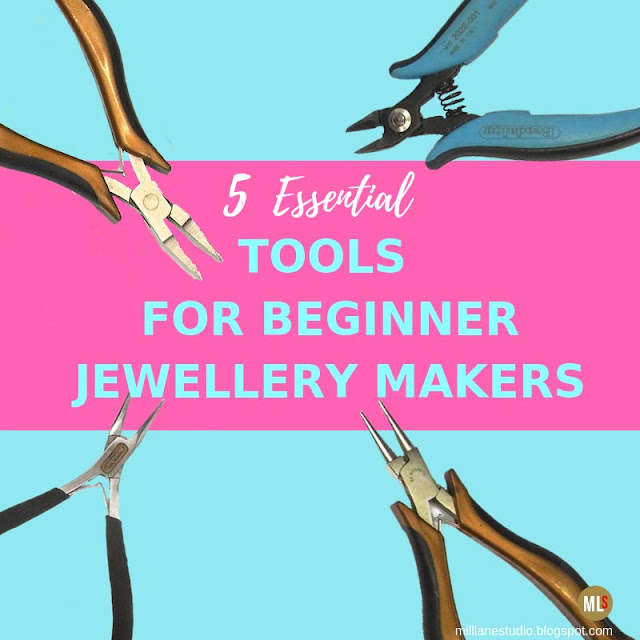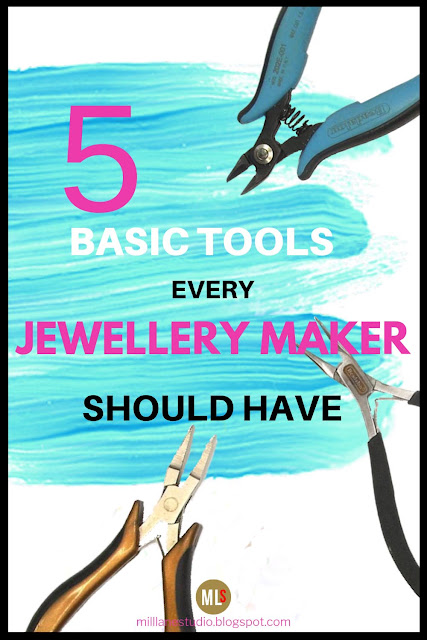Having the right tools for making jewellery helps you create jewellery that is professional and polished.
When you're starting out, you can easily feel intimidated by the huge array of tools available. They all look pretty much the same, right?!
Without knowing what each tool is used for, you might even be thinking, "Can't I buy just one pair of pliers and use it for EVERYTHING?"
Each pair of pliers has its own unique place in jewellery making. As your jewellery making skills develop, you'll want more and more of these tools.
But let's take a step back. There are some tools that are essential. All the rest fall in the "nice to have" category.
Today, we're going to concentrate on the ones that you NEED.
These are the ones you'll use every time you make jewellery... the workhorse tools that you can't do without.
Essential Jewellery Making Tools
There's no need to spend a fortune on your tools. You just want to invest wisely and buy quality tools that feel comfortable in your hand for extended use.
Here's my selection of basic tools you'll to start with and my recommendations for pliers that are at an affordable price point.
- Chain Nose Pliers
- Round Nose Pliers
- Flat Nose Pliers
- Wire Cutters, Side Cutters or Flush Cutters
- Bead Mat
Chain Nose Pliers have a flat surface on the inside of each jaw giving you good purchase when you grip things with them.
You'll use them to hold your findings, reach into tight spaces and open and close jump rings.
What to look for in chain nose pliers:
- a fine tapered point so that you can get into tight spots easily;
- a spring leaf mechanism to minimise the effort you need to exert when you use them;
- they should fit your hand size - i.e. not too large and not too small;
- soft-grip handles for comfort.
I use Beadalon Slim Chain Nose Pliers. These are so comfortable in my hand. Their longer, narrower handles gives you more leverage so they are effortless to work with.
Round nose pliers are my go-to tool for making loops. They have two round jaws which taper from the base to the tip so you can form loops of any size.
2. Round Nose Pliers
Round nose pliers are my go-to tool for making loops. They have two round jaws which taper from the base to the tip so you can form loops of any size.
Use round nose pliers for making loops in wire, headpins and eye pins.
What to look for in round nose pliers:
- ergonomic handles for a comfortable grip;
- a spring leaf mechanism to minimise fatigue when you use them for extended periods of time;
- a small gap between the base of the two jaws. If the gap is too large, you will find it difficult to grip the wire.
My choice for a beginner is the Beadsmith round nose pliers that are included in the Ergonomic 4 piece set. In fact, this is just an economical set to start out with because it has so many of the tools you'll use, all neatly contained in a zippered carrying case... so convenient!!
3. Flat Nose Pliers
Flat nose pliers have two broad, flat jaws designed for gripping larger surfaces. If you use round nose or chain nose pliers for this, you are likely to leave a dent on the surface of the wire.
Look for flat nose pliers with:
- a well-defined (sharp) edge on the jaws;
- a spring leaf mechanism to reduce hand strain
- ergonomic, soft-grip handles for comfort
I like the Beadsmith flat nose pliers from their Ergonomic 4 piece set
4. Flush Cutters, Wire Cutters and Side Cutters
There are a number of types of cutters to choose from: wire cutters, side cutters and flush cutters.
What's the Difference Between a Wire Cutter, Side Cutter and Flush Cutter
All three cutters cut wire. The difference is in the WAY they cut wire.
Wire cutters and Side cutters use a compression action to cut the wire. As you squeeze the handles together, they compress the wire and push it out of the blade's way whilst cutting it. This leaves a bevel (point) on both lengths of wire.
Flush cutters use a scissor cutting action and cut the wire with one flush side (desirable) and one pointed side. I highly recommend flush cutters... it takes much less force to cut wire with flush cutters than with wire/side cutters.
What to look for in flush cutters:
- a tapered tip so you can nip in difficult to reach places;
- a spring mechanism to give you more control;
- ergonomic shape to fit comfortably in your hand to reduce strain when cutting wire.
Tip: Cutters are NOT designed to be used with memory wire.
Cutting memory wire with your wire cutters will permanently damage the cutting edge of the blades. Use memory wire shears if you intend to work with memory wire.
This useful mat provides a cushioned surface to work on and prevents beads from rolling around your workspace or onto the floor.
5. Beading Mat
What to look for when selecting bead mats:
- a light shade for general use and a dark one for working with light coloured beads - it's much easier on the eyes!
BEFORE YOU GO:
Down the track, you can add more specialised pliers to your tool kit that will allow you to try more advanced jewellery techniques.
When you're buying your tools, keep in mind that your work will only ever be as good as the tools you use... Cheap tools will give you inferior results and mini tools will be difficult to work with.
When you're buying your tools, keep in mind that your work will only ever be as good as the tools you use... Cheap tools will give you inferior results and mini tools will be difficult to work with.
So, invest wisely and look for quality in the basic tools and they will last you for years.
Pin this for Later!
Happy jewellery-making!
'Til next time.....

Subscribe to my email list and learn how to resin like an expert.










